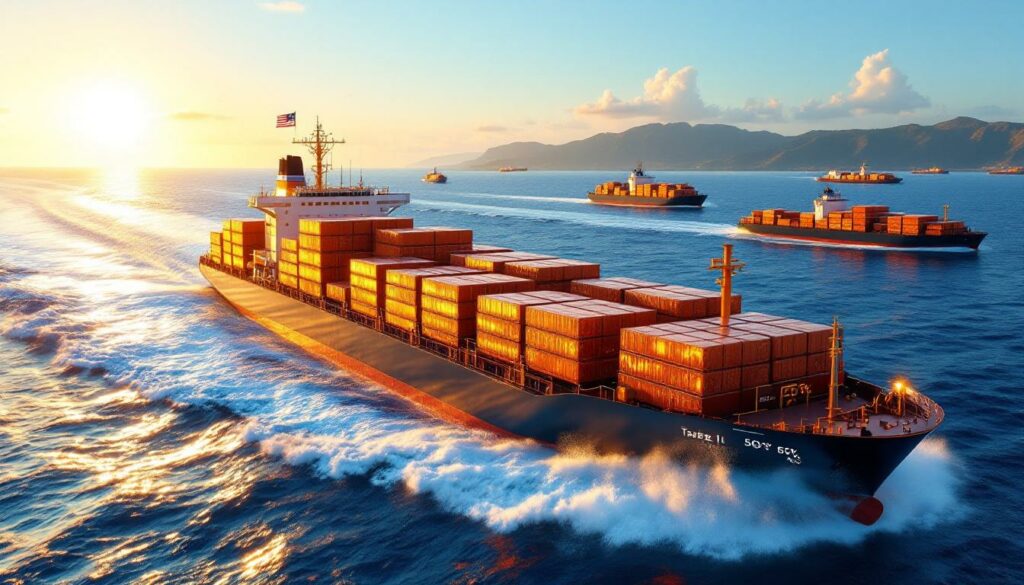The Race to Beat Copper Tariffs: Ships Rushing to US Ports
At least four vessels carrying thousands of tons of copper are currently racing against time to reach US ports before August 1, 2025, when unprecedented 50% tariffs take effect. This maritime dash represents one of the most dramatic episodes in global commodity trading history, with vessels modifying routes and destinations to shorten voyage times by up to 20 days.
"It's hard to say how efficient clearance will be in Hawaii, given that it's such an atypical destination for this cargo," notes Ben Ayre, a shipping analyst at Kpler, highlighting the extraordinary measures traders are taking to beat the deadline.
The stakes couldn't be higher. With London Metal Exchange (LME) copper prices hovering around $9,900 per ton, a 50% tariff translates to an additional $4,950 per ton – creating potential savings of over $74 million for a single typical bulk carrier loaded with 15,000 tons of copper.
The Urgent Maritime Dash Before August 1
Vessel tracking data confirms four ships are currently making this high-stakes journey to US ports. These vessels have altered their original routes, with some redirecting to closer US destinations despite these being non-traditional copper entry points. The rush extends beyond mere arrival – cargo owners face extremely tight timelines to complete customs clearance procedures before the August 1 deadline.
The most dramatic example is the bulk carrier Kiating, which departed Australia's Townsville port on July 16 carrying approximately 8,000 metric tons of copper. According to Kpler shipping data, the vessel changed its destination from New Orleans to Hawaii, cutting voyage time by nearly 20 days and positioning it to arrive by July 30 – just 48 hours before the tariff implementation.
For customs officials at these ports, the sudden influx presents unprecedented challenges. Hawaii rarely processes bulk copper shipments, raising questions about clearance efficiency and inspection capabilities on such short notice.
The High-Stakes Financial Motivation
The financial calculus driving this maritime scramble is straightforward yet staggering. At current market prices, a 50% tariff on a typical 15,000-ton copper shipment represents approximately $74.25 million in additional costs – an amount that transforms profitable trades into potential financial disasters overnight.
Industry veterans describe the current profit opportunities for those who can successfully navigate pre-tariff deliveries as "the biggest they've ever seen." Trading houses are exploiting unprecedented arbitrage conditions, with US copper prices having surged to record levels following the July 8 tariff announcement.
This represents the final opportunity to capitalize on pre-tariff price differentials, with no grace period confirmed for in-transit shipments. The situation has created a winner-takes-all scenario where delivery just hours before the deadline could mean millions in profits, while arriving just hours after could result in substantial losses.
Financial Impact Analysis: For a vessel carrying 15,000 tons of copper at the current LME price of $9,900/ton, the 50% tariff equals $4,950/ton, totaling $74.25 million in additional costs if cleared after August 1. This explains the extraordinary measures being taken to ensure pre-deadline arrival.
Which Vessels Are Involved in This Last-Minute Rush?
Australian Shipments Racing to Hawaii
The Kiating represents the most dramatic example of this tariff-avoidance race. Carrying 8,000 metric tons of copper from Townsville, Australia, the vessel's decision to divert to Hawaii instead of its original New Orleans destination slashes voyage time by approximately 20 days.
The cargo is believed to be linked to Glencore's Mount Isa Mines operations, one of Australia's largest copper producers. Shipping data shows Glencore has consistently supplied copper from this region to the US market, with the current shipment representing a typical volume from these operations.
Hawaii presents both advantages and challenges as an entry point. While geographically advantageous for Australian copper investments, the port lacks the specialized infrastructure and processing experience of traditional copper entry ports like New Orleans or Long Beach.
Latin American Vessels En Route
Three additional vessels are making similar last-minute dashes from Latin America:
- Louise Auerbach: Currently positioned near Colombia's Buenaventura port, heading to Tampa, Florida with an expected arrival of July 28
- BBC Norway: Currently in Panama waters, racing to beat the deadline
- BBC Campana: Anchored off northern Chile's coast, though its exact destination and ETA remain unclear
Chilean copper shipments typically require 10-15 days to reach southern US ports, placing these vessels on extremely tight timelines. Chile remains the largest copper supplier to the US market, making these shipments particularly significant in the pre-tariff rush.
How Did This Situation Develop?
Timeline of Tariff Announcements
The copper tariff situation represents a rapid policy shift that caught many market participants by surprise:
- February 2025: Initial consideration of copper tariffs began, with the Commerce Secretary directed to investigate foreign copper's impact on the US market
- July 8, 2025: Official announcement confirmed a 50% tariff rate – double what many analysts had expected
- August 1, 2025: Implementation date set, creating a narrow 24-day window for importers to adapt
The compressed timeline between announcement and implementation created the current scramble, as traders had little time to reposition vessels or accelerate shipments. Unlike previous commodity tariffs, no formal grace period for in-transit shipments has been announced.
Market Response to Tariff News
US copper prices surged to record levels following the July 8 announcement, creating even larger profit potential for traders who can successfully navigate pre-deadline deliveries. The price differential between US and international markets widened dramatically, triggering the rapid repositioning of vessels and cargo planning now underway.
The market response has not been limited to physical copper movements. Trading activity in copper futures contracts has also spiked, with significant price volatility reflecting the uncertainty surrounding post-tariff market conditions.
Commodity analysts note that the lack of clarity regarding potential grace periods for in-transit shipments has further complicated decision-making for traders. While previous tariff implementations for aluminum and steel included certain exemptions, the current copper tariff language has not explicitly addressed this issue.
Who Are the Key Players in This Copper Trade?
Major Trading Houses Involved
Several global trading powerhouses are at the center of this pre-tariff copper rush:
- Glencore: Active in the Australian-US route with connections to the Kiating shipment
- Mercuria Energy Group: Major participant in Latin American copper flows
- Trafigura Group: Significant presence in Chilean copper exports
- Hartree Partners LP: Active in specialty copper cathode trading
- IXM SA: Former Louis Dreyfus metals unit now owned by China Molybdenum
These trading firms are leveraging their global networks to source and redirect copper supplies to beat the deadline. Their sophisticated logistics operations allow for rapid decision-making and vessel repositioning that smaller market participants cannot match.
Industry veterans describe the current profit opportunities as historically unprecedented, with successful pre-tariff deliveries potentially yielding extraordinary returns. The situation has created intense competition for shipping capacity and port slots in the final days before implementation.
Strategic Shipping Tactics Being Employed
Traders are employing several innovative strategies to maximize their chances of pre-deadline clearance:
- Port prioritization payments: Paying premiums for preferential positions in port lineups, potentially converting days of waiting into mere hours
- Destination optimization: Rerouting vessels to closer US destinations despite these being non-traditional copper ports
- Customs acceleration: Attempting to clear customs at the first US port of call for entire cargo, rather than final destination ports
- Documentation preparation: Completing paperwork in advance to minimize processing delays
These tactics reflect the high stakes involved, with traders willing to absorb significant additional logistics costs given the potential tariff savings of millions per shipment.
What Are the Broader Implications of These Tariffs?
Economic Impact on US Copper Market
The implementation of 50% copper tariffs will have far-reaching consequences for the US economy:
- Price increases: Dramatic cost increases for domestic buyers and manufacturers who rely on imported copper
- Supply chain disruptions: Potential material shortages as import patterns shift and adapt
- Downstream effects: Higher costs likely to affect industries using copper as a key input, including:
- Electronics manufacturing
- Construction
- Renewable energy infrastructure
- Automotive production
- Power transmission equipment
A critical question remains whether domestic US production capacity can expand sufficiently to meet demand. The US relies heavily on imports to satisfy its copper requirements, with current domestic production covering only a fraction of consumption needs.
Global Copper Trade Flow Disruptions
Beyond US borders, the tariffs are already causing significant shifts in global copper trade patterns:
- Cargo redirection: Shipments originally destined for the US are being diverted to alternative markets
- Price differentials: Widening spread between US and international copper prices
- Trading strategies: New arbitrage opportunities emerging as market participants adapt
- Supply concentrations: Potential oversupply in non-US markets as diverted cargoes seek new buyers
Trading houses are rapidly repositioning to capitalize on these new market dynamics, with some firms specializing in complex multi-destination transactions that optimize around tariff boundaries.
The longer-term impact may include permanent changes to global copper supply forecast chains, with producers potentially developing dedicated supply lines for US and non-US markets to manage tariff exposure.
How Are Shippers Navigating Customs Challenges?
Customs Clearance Strategies
The final hurdle for pre-tariff deliveries is successfully completing customs clearance before August 1:
- Traders are racing to complete documentation and inspections with minimal delays
- Questions remain about processing efficiency at non-traditional copper ports like Hawaii
- Potential bottlenecks loom as multiple vessels attempt simultaneous clearance at key ports
- Critical distinctions between "arrival" and "clearance" timing may determine tariff application
Customs brokers report unprecedented demand for expedited services, with traders willing to pay significant premiums to accelerate processing. Some companies have stationed personnel at key ports to personally oversee clearance procedures and address any documentation issues immediately.
Regulatory Uncertainties
Several regulatory questions remain unresolved as the deadline approaches:
- Traders await clarification on potential grace periods for in-transit cargoes
- Previous tariff implementations for aluminum and steel suggest possible exemptions, but no confirmation exists for copper
- Customs authorities are preparing for a surge in last-minute processing requests
- Legal interpretations regarding exactly when tariffs apply (at berthing, customs filing, or final clearance) remain subject to debate
Industry associations have requested clarification from customs authorities, but definitive guidance remains limited. This regulatory uncertainty adds another layer of complexity to an already challenging situation.
FAQs About the Copper Tariff Situation
Why are copper tariffs being implemented?
The tariffs follow a Commerce Department investigation into the impact of foreign copper on the US market. The stated goal is protecting domestic producers and reducing import dependence on critical materials. Proponents argue the measures will stimulate domestic mining and refining capacity, while critics contend they will increase costs throughout the manufacturing supply chain.
How much copper does the US typically import?
The US relies heavily on imported refined copper, with Chile (approximately 33%), Canada (19%), and Mexico (17%) traditionally being major suppliers. Domestic production meets only a portion of US demand, making imports essential for manufacturing and construction sectors.
Will these tariffs affect consumer prices?
Yes, the 50% tariff is likely to increase costs for products containing copper, including electronics, construction materials, and industrial equipment. While the immediate impact will be on direct purchasers, economists expect these costs to eventually reach consumers through higher prices for copper-intensive products like air conditioners, motors, and wiring.
Are any countries exempt from these copper tariffs?
The current information doesn't indicate any country-specific exemptions, though final implementation details are still emerging. Previous commodity tariffs have sometimes included exemptions for key allies or trading partners, but no such carve-outs have been announced for copper.
What happens to shipments that arrive after August 1?
Vessels arriving after the deadline will face the full 50% tariff unless specific grace periods are announced for in-transit cargoes. The exact definition of "arrival" (whether it means reaching territorial waters, berthing at port, or clearing customs) remains subject to interpretation and could significantly impact borderline cases.
Disclaimer: This article contains information about market conditions and regulatory changes that may impact investment decisions. The situation remains fluid, and details may change as further clarification emerges from authorities. Readers should consult with qualified advisors before making trading or investment decisions based on this information.
Further Research and Related Topics
Copper market participants should monitor developments in several related areas:
- Potential exemption requests: Industry groups may file for product-specific or country-specific exemptions
- Domestic production response: US mining companies' plans to increase output
- Substitution effects: Alternative materials that may replace copper in certain applications
- Secondary market developments: Impact on copper scrap and recycling flows
- Legal challenges: Potential WTO or court actions contesting trade war impact on copper
The copper-laden ships racing to reach US shores ahead of Trump's 50% tariffs represent just the first visible impact of a policy change that will reshape global metal markets for years to come. Furthermore, this situation creates both challenges and opportunities for investors seeking the most effective copper investment strategies in this volatile environment.
According to a recent Bloomberg Tax report, these tariffs could significantly reshape global metal trade for years to come. Additionally, market analysts at LiveWire Markets suggest the tariffs could create unexpected winners among certain mining stocks, making accurate copper price prediction more crucial than ever for investors navigating this complex landscape.
Ready to Identify the Next Major Mining Discovery?
Discovery Alert's proprietary Discovery IQ model instantly notifies investors of significant ASX mineral discoveries, providing actionable insights before the broader market. Explore how major discoveries have historically led to exceptional returns by visiting Discovery Alert's dedicated discoveries page and position yourself ahead of the market.




